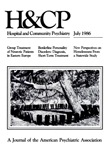Reconceptualizing Assumptions About Community Mental Health
Abstract
Beliefs that patients fall between the cracks in the transition from hospital to community services, that the aftercare population is shut out of community mental health agencies, and that services are duplicated to a high degree continue to be widely accepted. Using data from a study of a publicly funded mental health aftercare system in a major urban county, the authors neconceptualize these and similar assumptions about mental health aftercare. It appears that the primary focus of concern should be on the nature and quantity of the services being delivered rather than on increasing the proportion of patients connecting with them. Current services appear to be largely oriented toward helping the patient maintain a borderline existence in the community. instead, much more emphasis is needed on meaningfully rehabilitating patients and reducing their chronic need for professional support.
Access content
To read the fulltext, please use one of the options below to sign in or purchase access.- Personal login
- Institutional Login
- Sign in via OpenAthens
- Register for access
-
Please login/register if you wish to pair your device and check access availability.
Not a subscriber?
PsychiatryOnline subscription options offer access to the DSM-5 library, books, journals, CME, and patient resources. This all-in-one virtual library provides psychiatrists and mental health professionals with key resources for diagnosis, treatment, research, and professional development.
Need more help? PsychiatryOnline Customer Service may be reached by emailing [email protected] or by calling 800-368-5777 (in the U.S.) or 703-907-7322 (outside the U.S.).



